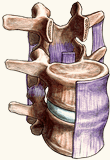Spinal Stenosis Diagnosis
Spinal stenosis is a condition caused by narrowing of the spinal canal and/or a reduction in size of the bony openings where nerves pass through and branch out from the spine. The condition most often occurs in the lower back and is usually caused by degenerative changes in the spine. Some patients are born with this narrowing; however, stenosis usually develops in patients over age 50.
Pain is attributed to nerve or spinal cord compression and commonly extends from the lower back down into the lower leg. One or both legs can be affected. The primary symptom of spinal stenosis is leg pain that worsens with walking/standing and improves when sitting. Patients typically stoop forward when walking or lean over something such as a grocery cart or counter, as this places the spine in flexion and reduces symptoms. MRI is the best way to diagnose spinal stenosis.
Treatment of Spinal Stenosis
Most treatment for spinal stenosis is done electively. Although painful, stenosis rarely leads to catastrophic failure or loss of nerve function. Typical recommendations for treatment include anti-inflammatory medications and physical therapy. Epidural injections or nerve root blocks are commonly done and are effective for managing symptoms.
Surgery to Treat Spinal Stenosis
If non-surgical treatment fails to control symptoms, then surgery can be considered. There are different surgical techniques to treat lumbar stenosis. The goal of surgery is to decompress (take pressure off) the spinal cord and nerve roots. Decompression involves removing or trimming whatever is causing compression usually bone spurs (osteophytes) and thickened ligament (ligamentum hypertrophy) that arise from the enlarged facet joints (facet hypertrophy).
Laminectomy
Decompressive laminectomy is a common surgical procedure to treat lumbar stenosis. This procedure removes the lamina (vertebral roof) to create more space in the spinal canal for nerves. If only part of the lamina is removed, the procedure is a laminotomy or hemi-laminectomy. If the stenosis/nerve compression involves only one side of the spine and one spinal level, surgery can be done using minimally invasive techniques in an outpatient setting. Stenosis affecting multiple levels (spinal segments) may require more surgery and necessitate a short hospital stay.
Surgery yields the best outcomes in those patients who have failed non-surgical care and have a predominance of lower limb pain as opposed to back pain. Patients with lower back pain alone and spinal stenosis generally do not obtain good results from decompression surgery.
Results from surgery can vary greatly. While an overwhelming majority of patients will note a reduction in pain after this type of surgery, few patients are ever completely pain free as a result. Your surgeon can determine if you are a good candidate for surgery, and provide you with all the information you need to make an informed treatment decision.




 Dr. Kwon specializes in treating adult spine disorders. Whether you’re suffering from neck or back pain, Dr. Kwon will provide you with all the information you need to make an informed treatment decision.
Dr. Kwon specializes in treating adult spine disorders. Whether you’re suffering from neck or back pain, Dr. Kwon will provide you with all the information you need to make an informed treatment decision.